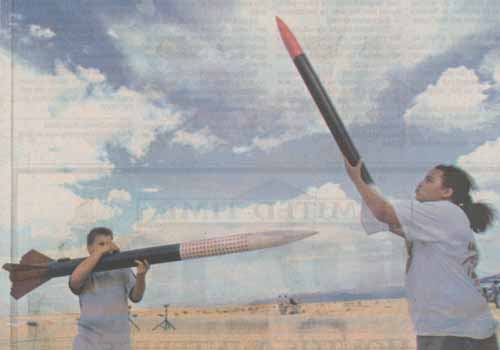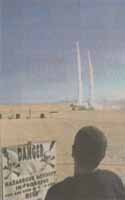Aiming High (ARLISS)
Some members of AERO-PAC, organized by Tom Rouse, worked with Professor Bob Twiggs
of Stanford to build rockets to launch student satellites from amateur rockets at the
Black Rock Desert. For more information about the program, see the
ARLISS web site.
This page reproduces a San Jose Mercury News article of September 12, 1999 focusing
on the launch and one group of young rocketeers from Redwood City
(the other three groups were college students from Japan and the U.S.).
Note that you can find the article at the
SJMN web site,
but without pictures.

Launches designed to fuel kids' dreams
BY S.L. WYKES
Mercury News Staff Writer
BLACK ROCK DESERT, Nevada - The hopes of 20 Redwood City middle-school students soared 12,000 feet high Saturday into the hot sky of this desert, traveling at more than 600 mph in three Coke-can-size satellites snuggled inside a rocket built especially for them.
"There we go!" the Kennedy Middle School kids yelled in an excited chorus. They are among America's youngest satellite builders, getting their start years ahead of most other eager amateurs.
 The students' invitation to this rarefied club came from Stanford aerospace
professor Bob Twiggs, who has made a habit of pushing the edges of his
field. He came up with the idea of putting these one-pound satellites into
the hands of children to lure them into scientific study and, maybe,
involvement in space.
The students' invitation to this rarefied club came from Stanford aerospace
professor Bob Twiggs, who has made a habit of pushing the edges of his
field. He came up with the idea of putting these one-pound satellites into
the hands of children to lure them into scientific study and, maybe,
involvement in space.
The students were able to field test their satellites under real operating conditions, something usually reserved for a few college students, private companies and the National Aeronautics and Space Administration. But they also learned a hard lesson.
Although the late afternoon launch was flawless, the students had less success with the video pictures that the satellites were supposed to send back of their parachute drop to Earth, along with temperature, wind and other data. They were able to snatch just a few moments of data on the directional antennas they angled toward the falling satellites.
"We were looking forward to seeing (images) on the screen," said seventh-grader Brian Walsh, who admitted he was a bit disappointed. "Oh well. We tried."
They did more than try. The students arrived at this rocketry proving ground at 7 a.m. and, in the hours that passed while technical difficulties were solved, 10 of them built their own slender rockets to blast off without payloads. Although the satellites were not intended to orbit the Earth as they would in a real launch, the thrill of those takeoffs was immeasurable.
"Oh my God!" shouted one boy as he watched his craft take to the skies. "Next time, you're going to see me with a big rocket, if I save up all my money," said seventh-grader Matt Alfaro.
The elaborate field trip came together with an ingenuity borne of the devoted passion of Twiggs, Kennedy school administrators and some amateur rocketeers The kids built their satellites with the help of a Twiggs-recruited mentor, electronics whiz Dave Joseph. Kennedy math teacher Loren Dakin lent his organizational skills and rapport with kids. Dakin found two l0th-graders, former students of his, to come along as technical assistants. "I've always been a geek at heart," said Brian Pugh, one of them.
 That didn't matter to sixth-grader Liz Godinez, who, like everyone else,
endured with good grace the 400-mile plus trip made in an
un-air-conditioned school bus. "I want to be an astronaut I've always liked
to learn about space."
That didn't matter to sixth-grader Liz Godinez, who, like everyone else,
endured with good grace the 400-mile plus trip made in an
un-air-conditioned school bus. "I want to be an astronaut I've always liked
to learn about space."
Kennedy principal John Brand played a part in the trip, too. He sees this program, which will continue with more satellite building and another possible launch next summer, as something to "build big. ... We believe this is all part of learning."
"If these kids are willing to work hard," said Dakin, 'they will be a lot farther ahead when they reach high school."
The plan is to maintain these students' relationship with their satellite-building mentors through high school and, when they go to college, to ask them to come back to Kennedy as mentors.
Twiggs sees the students as satellite builders of the future.
"This is a way (for the students) to find out how the real world works, that there are challenges, that there are ways to overcome them and get done what you want to get done," Twiggs said.
Some of the students at Saturday's launch also took inspiration from "October Sky," the highly praised film that depicts the story of Homer Hickam Jr., who grew up in a West Virginia coal town. As a teen desperate to escape the grim town, he falls in love with rocketry, goes on to win a national science fair with a homemade rocket and, years later, becomes a NASA engineer.
At the helm of Saturday's mode rocket experiment is William Walby, who was likewise inspired in his youth by space exploration. Walby is a commissioner of AERO-PAC, the Association of Experimental Rocketry of the Pacific, a non-profit group dedicated to the advancement of nonprofessional, high-powered rocketry.
Three times a year, AERO-PAC's amateur rocket enthusiasts are allowed on the desert flats to test their creations. A hobby whose field practice is highly regulated - certification must be granted for each succeedingly powerful rocket - it has attracted serious devotees.
With Saturday's experience, the Redwood City students are years ahead of their peers, Walby said.
Twiggs also organized the student production of NUSAT, the first college-built satellite ever orbited above Earth. It was launched by the space shuttle Discovery in 1985.
Twiggs, who also got caught up in the hoopla around John Glenn's original orbital flight, is widely credited with bringing the rocket program to Stanford, his alma mater, in 1994. Since then, Twiggs and his students have become masters at making satellites one-tenth the size and cost of others. Twiggs and other academic proponents recently persuaded the U.S. Air Force and the Department of Defense to invest nearly a million dollars in a first-ever program to support 10 university-based satellite-building programs.
But he doesn't doubt that the future will attract more students like Redwood City's. "Space, space," mused Twiggs. "There's still a mystique about it."
Contact S.L. Wykes at swykes@sjmercury.com or (650) 688-7599. Fax (650) 688-7555.